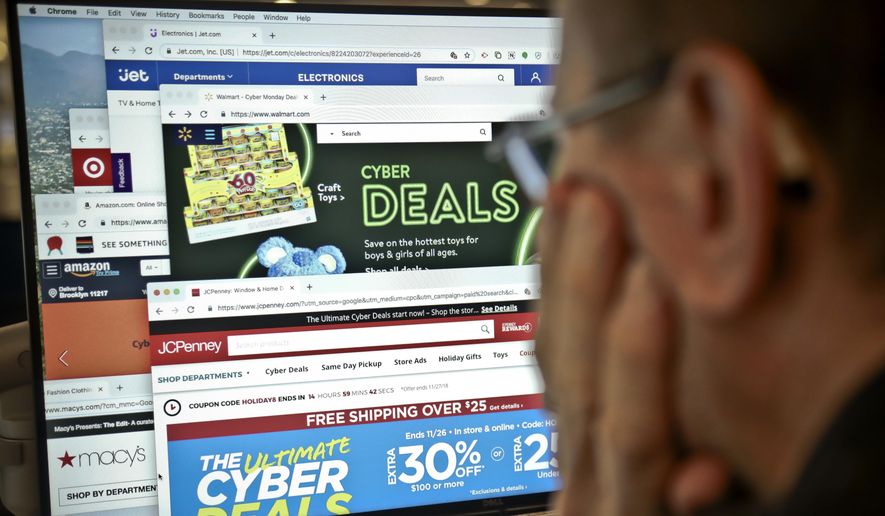If you’re price-shopping online for deals on name-brand Christmas gifts, your odds of getting “Dove lotion” full of harsh chemicals or a “Romex” instead of a Rolex just went up.
Third-party sellers are flooding digital marketplaces with a rising tide of knockoffs from countries like China as more Americans seek discounts to cope with high inflation this season, officials warn.
“If a product’s price seems too good to be true, it may be counterfeit,” Nikki Fleming, a spokeswoman for the U.S. Consumer Product Safety Commission, told The Washington Times. “Don’t buy it.”
Cheap imitations of name-brand products often appear in social media ads and pop-up links, experts say. They include high-end smartphones, jewelry, clothing and handbags.
Shoppers should avoid unknown sellers and buy directly from manufacturers or trusted retailers, Ms. Fleming said. She also suggests checking products for testing certification marks, manufacturer labels, misspellings and grammar errors to identify fakes.
The commission works with U.S. Customs and Border Protection to intercept counterfeit goods flowing from other countries into U.S. ports, where authorities have flagged a recent surge.
In late October, agents from Customs and Border Protection and Homeland Security Investigations seized eight shipments of counterfeit cosmetics and phony NFL apparel from the port of New Orleans. They said everything confiscated in the two-day raid originated in China and Korea.
The two agencies seized 27,000 shipments of knockoff goods, worth a total of $3.3 billion in the suggested retail value of the imitated products as of fiscal 2021. One-third of those goods came from China, the leading source, followed by Hong Kong, Turkey, the Philippines and Colombia.
According to Customs and Border Protection, clothing and accessories represented 30% of intellectual property-related seizures last year. Confiscated watches and jewelry were valued at over $1.18 billion, representing 36% of the total, while handbags and wallets came in at over $972 million.
The growth of consumer prices and online shopping has created a bigger market for fakes this year, said Mark D. Solomon, vice president of the International Association of Financial Crimes Investigators, a California-based nonprofit.
“With inflation on the rise, consumers are looking for ways to purchase merchandise at less expensive prices,” Mr. Solomon said.
Foreign governments often encourage counterfeiting to hurt consumer confidence in U.S. brands, he added.
“China is one of the leading countries behind counterfeiting merchandise as well as the theft of intellectual property,” Mr. Solomon said in an email. “The goal is to negatively impact the U.S. economy and redirect consumer spending to foreign entities.”
Online shopping fraud makes up more than a third of scams reported to the Better Business Bureau. And 36% of BBB retail fraud reports originate from copycat or fake websites.
Imitations of popular brands of hoverboards, iPhone chargers and helmets have the added danger of exploding or catching fire, said Brian Pomper, executive director of the Alliance for Trade Enforcement.
“Counterfeit goods are dangerous because they do not adhere to the same health and safety standards as legitimate products,” said Mr. Pomper, whose Washington-based coalition of 17 business associations lobbies to close foreign counterfeiting rings. “Counterfeit water filters can even expose consumers to lead or mercury poisoning.”
Fake products threaten “hundreds of thousands of American jobs” by costing the U.S. economy an estimated $225 billion annually, he added.
“Yet this data only shows a sliver of the fake goods coming into the country,” Mr. Pomper said, noting the failure of officials to catch it all.
Not even children are spared from dangerous holiday knockoffs, according to the toy industry. Many websites sell off-brand car seats, helmets and toys the industry says could be fatal to young ones.
“Unlike legitimate toys, which are tested for compliance with over 100 safety standards and tests, counterfeit and imitation toys, usually sold online by unscrupulous sellers, are unlikely to comply with our nation’s strict product safety laws,” said Adrienne Appell, an executive vice president at the Toy Association.
Fraudsters commonly advertise the knockoffs on social media platforms popular with kids, said Jay Foreman, CEO of Basic Fun!
“The online marketplace is very much like the online social media space,” said Mr. Foreman, whose toy company makes Tonka Trucks and Lincoln Logs. “The most popular sites like Twitter, Facebook and Amazon are often too big to police the products and speech that travels across their platforms.”
Counterfeiters are especially quick to imitate out-of-stock toys with expensive components, said Nelo Lucich, CEO of the toy company Skyrocket.
“These products could be dangerous and contain banned substances, faulty construction, dangerous safety issues and a range of other issues,” Mr. Lucich said in an email.
Skyrocket’s popular Moji the Lovable Labradoodle, a lifelike toy dog with a smart collar that retails at $99.99, created a black market last year when it ran out of stock during a global shortage of computer chips.
Other telltale signs of counterfeiting include online sellers who insist on direct payment through apps like Venmo rather than a credit or debit card.
Consumers who receive unsafe knockoffs in the mail should report them to Customs Border and Protection or the National Intellectual Property Rights Coordination Center, said Scott Hall, a senior director at the U.S. Chamber of Commerce.
He noted that fake cosmetics often contain arsenic, mercury or lead, and generic batteries can cause fires.
“If companies can make it, counterfeiters will try to fake it,” Mr. Hall said in an email.
• Editor’s note: Mark D. Solomon of the International Association of Financial Crimes Investigators is the brother of a former editor-in-chief at The Washington Times.
• Sean Salai can be reached at ssalai@washingtontimes.com.




Please read our comment policy before commenting.